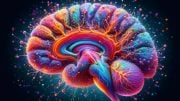
Researchers discovered waves of blood flow across the mouse brain cortex, which could help mix brain fluids and remove waste, potentially protecting against diseases like Alzheimer’s. Credit: SciTechDaily.com
An NIH-funded study challenges conventional wisdom by revealing that blood flow creates waves across the surface of the mouse brain.
For the first time, researchers have mapped the entire network of blood vessels in the cortex of conscious mice, discovering rhythmic expansions and contractions of these vessels that create “waves” across the brain’s surface. Supported by the National Institutes of Health (NIH), this study enhances our knowledge of blood delivery to the brain, although the purpose of these waves is still a mystery.
A network of elastic and actively pumping vessels carrying oxygenated blood spans the surface of the brain before entering the cortex. There, they feed into a second network of capillaries that supply oxygen deeper into the tissue. Using physics-based experimental methods and analyses, the researchers saw that in addition to the pulses of blood flow that occur with each heartbeat, there are slower waves of blood flow changes that sweep across the brain and occur about once every ten seconds.
The changes in blood flow that occur with these slow waves were up to 20% of the entire brain blood supply. Surprisingly, this phenomenon was only weakly tied to changes in brain activity.
Implications of Vascular Activity
The waves produced visible bulges in the blood vessels, which will aid in mixing the fluid around the brain’s cells. This has implications in how waste products and other materials are removed from the fluid surrounding brain cells. Because the waves of bulging blood vessels move in a variety of directions, the authors surmise that the pulses of dilation and contraction of the blood vessels are more likely to be involved in mixing the fluid around them rather than actively moving it in a given direction. Regardless, this mixing activity could aid in removing misfolded proteins and other components from the brain into the cerebrospinal fluid that surrounds it. This process is considered an important protective mechanism for a variety of neurological disorders, such as Alzheimer’s disease and other related dementias, and is more active during sleep.
These findings may also affect current approaches to interpreting fMRI scans, which measure changes in blood oxygenation within brain structures as they are activated. Specifically, the finding that these waves of blood flow changes occur largely independent of brain activity suggests a new level of complexity complication that needs to be considered when interpreting the link between the fMRI data and brain activation.
Reference: “Long-wavelength traveling waves of vasomotion modulate the perfusion of cortex” by Thomas Broggini, Jacob Duckworth, Xiang Ji, Rui Liu, Xinyue Xia, Philipp Mächler, Iftach Shaked, Leon Paul Munting, Satish Iyengar, Michael Kotlikoff, Susanne J. van Veluw, Massimo Vergassola, Gal Mishne and David Kleinfeld, 22 May 2024, Neuron.
DOI: 10.1016/j.neuron.2024.04.034
This research was funded in part by the NIH’s Brain Research Through Advancing Innovative Neurotechnologies® (BRAIN) Initiative (U19NS123717, R01NS108472), the NIH’s National Institute of Neurological Disorders and Stroke (R35NS097265), the NIH’s National Institute of Mental Health (R01MH111438), and the NIH’s National Institute of Biological Imaging and Bioengineering (U24EB028942, R01EB026936).









I am facing neurological problems,any solutions